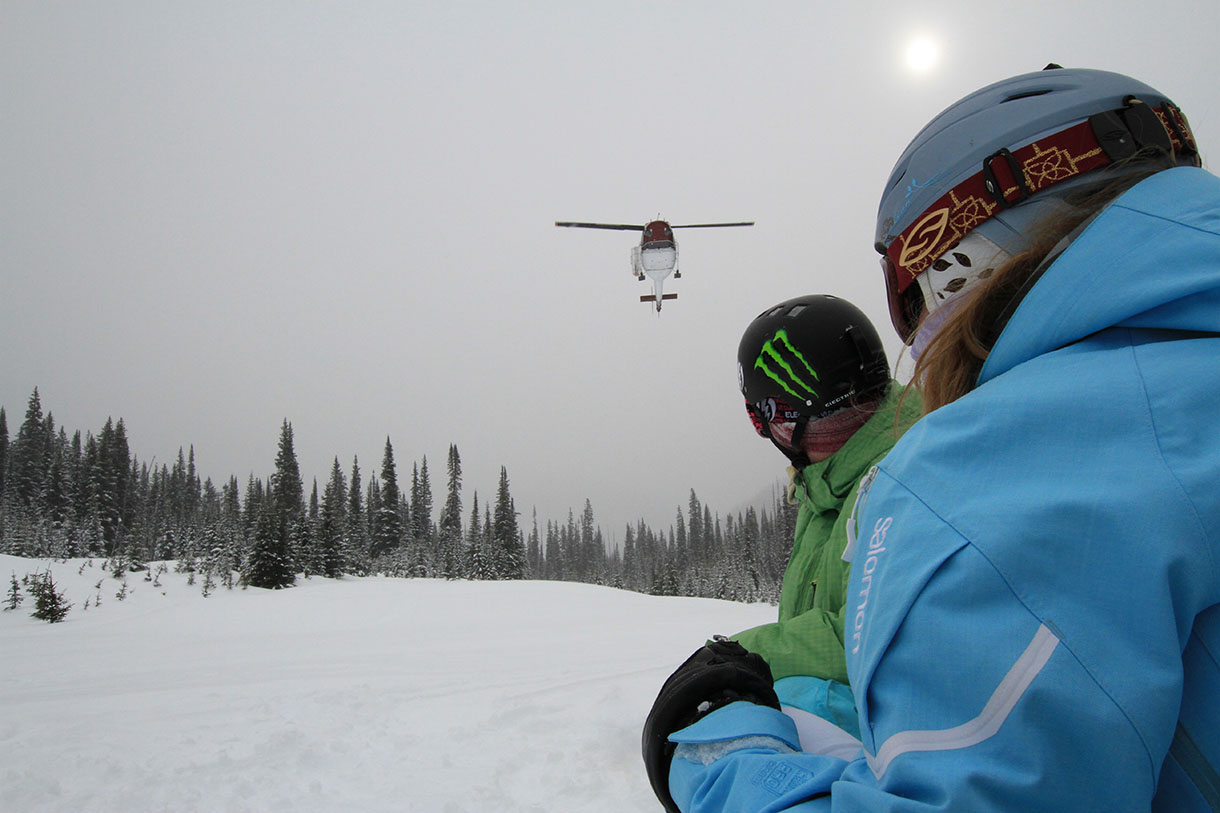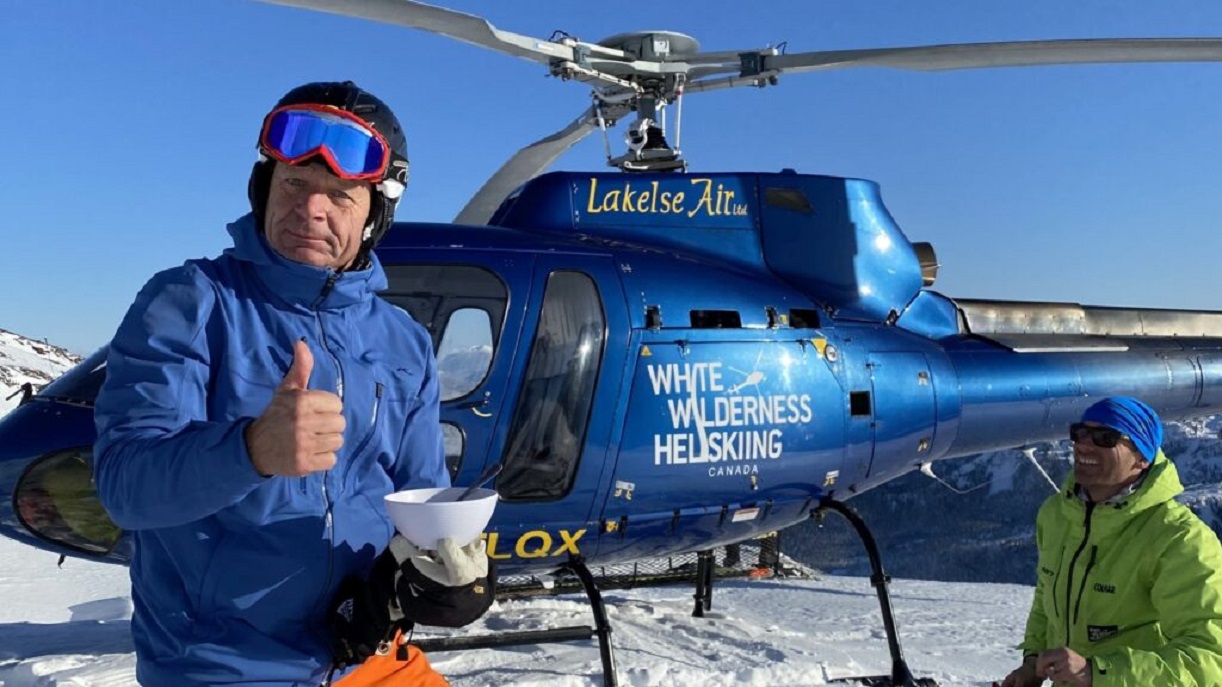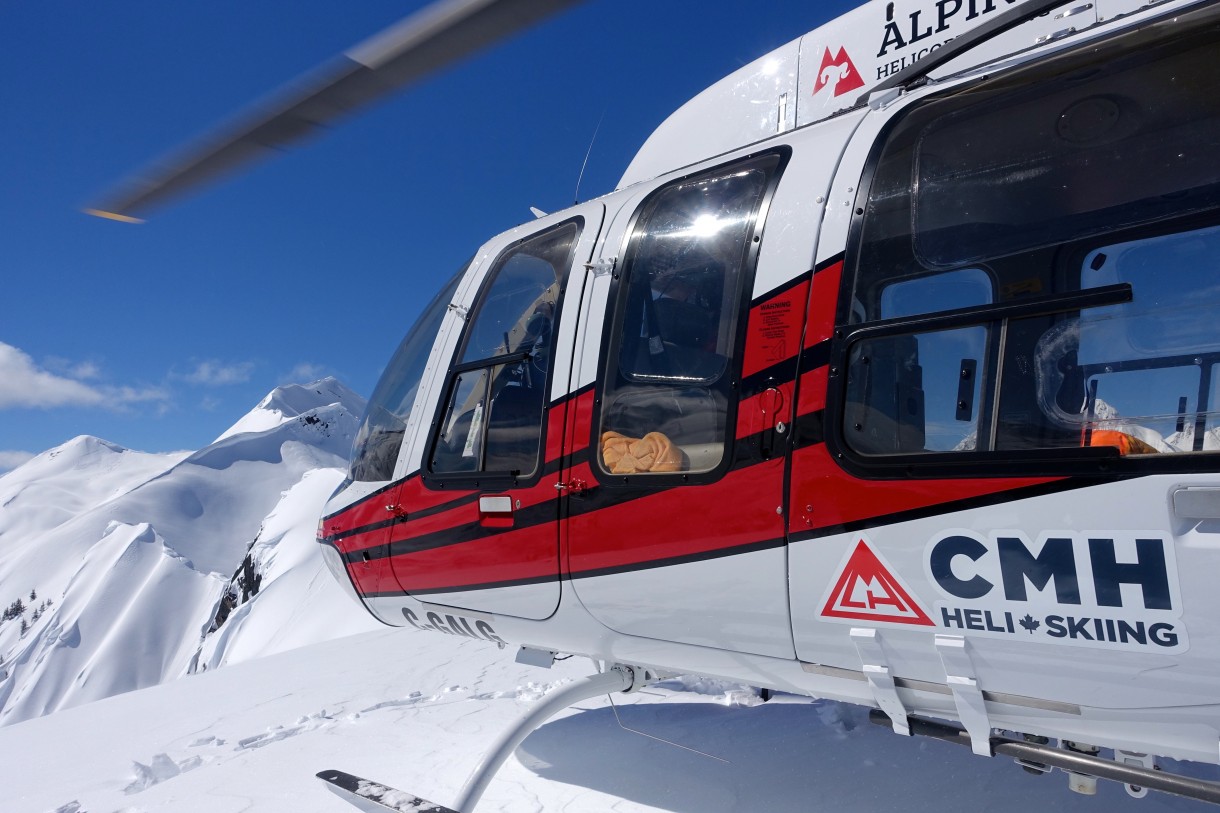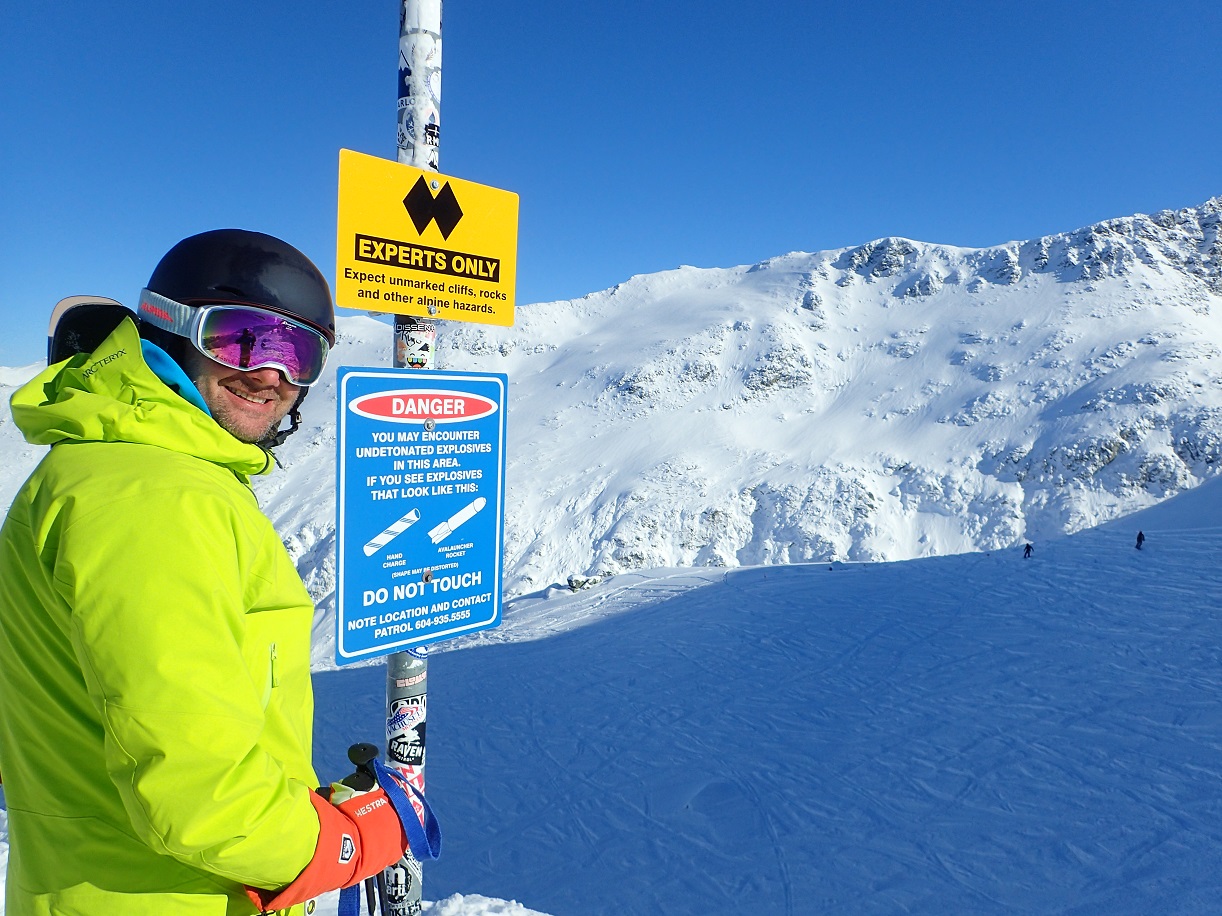
My first heliskiing day: rollercoaster ride of emotions
Insanely beautiful or pure madness? Heliskiing is both and everything in between! Especially for first-timers, the most exclusive form of skiing and snowboarding is a real adrenaline rush.
 Minus 20 degrees Celsius is no pleasure. Not even on a powder day in Canada. But in this freezing cold, the powder snow is not only as dry as a good martini, the frosty temperatures are also the condition for a unique natural spectacle: In the Rock Garden of Lake Louise, a tiny cloud of steam rises from the ground. However, it does not come from a hot spring, but from a cave. In the crystal clear air you can see the breath of a grizzly bear. A few meters below our skis, the bear is hibernating, my guide Sandy Best tells us. Welcome to Canada, the ski adventure land where I finally want to realize my dream of heliskiing.
Minus 20 degrees Celsius is no pleasure. Not even on a powder day in Canada. But in this freezing cold, the powder snow is not only as dry as a good martini, the frosty temperatures are also the condition for a unique natural spectacle: In the Rock Garden of Lake Louise, a tiny cloud of steam rises from the ground. However, it does not come from a hot spring, but from a cave. In the crystal clear air you can see the breath of a grizzly bear. A few meters below our skis, the bear is hibernating, my guide Sandy Best tells us. Welcome to Canada, the ski adventure land where I finally want to realize my dream of heliskiing.
Heliskiing is for everyone
Heliskiing is only for real experts and daredevils, I always believed. In my fantasy I saw myself jumping out of a flying helicopter with skis in James Bond style. No, I am definitely not good enough for heliskiing and certainly not brave enough! Sure, I can ski down any slope and I’ve even dared to ski in knee-high powder. But being dropped off by a helicopter somewhere in the Rockies and then sinking forever into waist-deep snow – no, that’s definitely nothing for me, I’ve always said.
„But it is!“ said Bap Koller, and he should know better. The Bavarian is a certified ski instructor and specialist for heliski and catski tours in Canada. RK Heliski in Panorama has programs specially designed for heliski beginners, Koller told us. Even skiers of average ability are introduced to the adventure of heliskiing. And at 630 euros for a trial day with three flights, the costs were also kept within reasonable limits.
Warming up for heliskiing in Lake Louise
Three months later, I am actually standing in Canada. On the way to Panorama, I made a stopover in Lake Louise to acclimatize and warm up. Because of the proximity to the airport, the many off-piste runs and for guys like Sandy Best, who takes me to the unique Rock Garden on my first day in Lake Louise. When he’s not sitting on his own island in Fiji, he works for Lake Louise Ski Resort. Firstly because he is a friend of the owner Charles B. Lock, but mainly because he is a passionate skier. Nothing and no one can keep the charismatic man off the mountain – no cold snap, no blowing snow and no injury. One of his wrists is stiffened with a steel plate, his knees patched up many times.
But I don’t feel any of that in the soft fresh snow, Sandy says, pointing up to the meter-high boulders at the foot of the Rock Garden, their corners and edges cushioned by snow pillows. Many thousands of years ago, a gigantic rock fall created this Zen garden for giants, where grizzlies hibernate and skiers try their hand at rock slalom.
Most scenic ski resort
The famous ski resort in the province of Alberta is one of the largest ski areas in North America and certainly the most scenic in Canada. Only a 30-minute drive from Banff, Lake Louise is located in the middle of the wilderness of the Rocky Mountains. You can see endless forests, lakes, rivers and mountain peaks. From the front of the mountain, with its wide pleasure runs and World Cup racing pistes, you look across to the Fairmont Hotel Chateau Lake Louise. Below the Victoria Glacier, the legendary property sits right on the frozen lake where skaters and cross-country skiers make their rounds and kids play ice hockey.
Just as impressive as the postcard idyll around the Chateau is the ski area. Especially the Powder Bowls on the backside of 2,672-meter Mount Whitehorn. Even though the off-piste runs are monitored by Ski Patrol, I carry the ABS avalanche backpack on my back for safety and have the Ortovox avalanche transceiver strapped on. The idea of having to use all this once in an emergency makes me nervous, although the poison green part under my Arcteryx jacket somehow also looks cool. But the safety equipment has to be there and your preparation for heliskiing should be as realistic as possible, Sandy says. First he leads me into the bowls, where I do quite well, but then he heads for the woods below the Ptarmigan chairlift.
Keeping the rhythm while tree-skiing
„Let’s go tree-skiing,“ Sandy shouts with anticipation as the color drains from my face. And this time it’s not because of the cold. Where else in the Alps can you ski through forests in a wild slalom? I don’t have the experience. Sandy playfully prances through the trees, I crampedly curve around the trunks. Don’t look at the trees and keep the rhythm, Sandy recommends. If it would be that easy!
But Sandy is right when he says: Heliski doesn’t always mean open glaciers, knee-high powder, blue sky and sun. Bap Koller has already told me that quite honestly. The helicopters are not allowed to go up through cloud cover, so they don’t fly as high in bad weather, and then you just ski in the woods, so any practice runs between the trees are welcome before my heliski adventure.
The next day at noon, after a shopping tour, I drive over the Main Street of Banff to the Panorama Mountain Village in British Columbia. The drive takes just under two hours, a stone’s throw by Canadian standards.
Hot pools for relaxation in Banff
The ski in-ski out resort of Panorama nestles right up against the slopes. A few imposing villas made of wood and natural stone stand alone at the edge of the forest, but the apartment buildings are grouped around the small ski arena in town, where the lifts start and all the slopes converge. To the left, dense clouds of steam now drift into the starry sky in the evening. They rise from several pools of hot water in which skiers relax their battered muscles.
The next morning, Bap Koller is already waiting for me at the Mile 1 chairlift. Before I climb into the helicopter for the first time tomorrow, he prepares me for the adventure today in the ski area. Bap has come up with this gentle introduction for his heliski first timer program. He himself is in Panorama today by accident, so he takes care of me in person. Normally one of RK’s heliski guides takes over the preparation day. The ski area of Panorama is ideal for this, after all the Tanyton Bowl was till recently a pure heliski area.
Getting into Canada’s top resorts
Before we plunge from the 2,400-meter summit of Panorama Mountain into the forest terrain runs of Tanyton Bowl, some of them extremely difficult, we ski our way down groomed slopes on which World Cup races have already been held. After the first wide bends, Bap demands short turns. Stay in rhythm, control your speed, that’s the motto. Just like in deep snow, says Bap and gives me a few tips here and there so that I avoid the deadly backward lean in deep snow. That’s no problem on groomed slopes, but it’s a different story on off-piste runs between dense trees.
Over a burger with smoked salmon in the Elkhorn cabin, Bap tells us how much value the Canadians attach to safety. The pilots and guides are fantastically trained. All heliski operators within a region exchange information daily about weather, snow conditions and avalanche danger. This is calming.
First contact with the heli
In the afternoon, we do a few more laps in the woods, then head over to the heliski base, where Rod Gibbons is already waiting. The chief guide of RK explains to me what is allowed to touch the helicopter and what not, how to approach it, how to get in and out. Fortunately, he says nothing about jumping out à la James Bond. For first-timers, I like to do this briefing the day before. This makes the already exciting first day of heliskiing more relaxed, explains Bap.
Maybe, but I still slept badly during the night, and on day X I’m standing at the heli base at eight in the morning with a tingle in my stomach. One by one, my fellow pilots trickle in, most of them rank heliski beginners like me. The more experienced ones get into another group. Thank goodness. I don’t need a bunch of impatiently waiting cracks, especially since there is no sign of the expected glorious weather. The sky is cloudy, it is snowing lightly and it is minus 15 degrees Celsius.
One practices the emergency
In the heli-base there is first breakfast: thin coffee and thick omelets. Meanwhile Rod explains what to do in case of an avalanche. He shows how the radio, probe and shovel work. The cracks are calmly munching on eggs and bacon, while we beginners stare tensely at Rod. Outside, nimble helpers have already prepared fat skis for us. The wide slats make deep snow skiing much easier, Rod promises, and invites everyone to safety training in the parking lot. He conscientiously explains the function of the avalanche transceiver and shows once again how such a search proceeds in an emergency. Then we practice searching and recovering ourselves.
While the others still have to go to the helicopter briefing, I go back to the log cabin and warm up by the fireplace, trying to relax. Then it goes off. Slightly bent over, I walk towards the helicopter, drag my bound skis behind me and pass them on to Rod together with my ABS backpack. He stows everything in the outer basket while we climb into the helicopter and strap ourselves in. A few minutes later, the helicopter takes off. The rotors hammer even louder than my heart. The deafening noise in the helicopter somehow reminds me of movies about the Vietnam War. You’re not flying to war, you’re flying to ski, I admonish myself.
A good ten minutes later, the helicopter sets us down on a gentle knoll. We can’t go high up on the easier glaciers, the clouds are too thick. Disembarking goes smoothly. We huddle sideways in front of the helicopter, which gives us a peeling with the swirling snow crystals as it takes off.
Suddenly there is silence. Almost moved, we look around at nothing but white wilderness. The swirling snow crystals trickle down on us like in a snow globe. Rod is the calm itself, we get a little hectic. It’s not easy to get into the bindings in the deep snow, and the avalanche backpack also needs to be tightened. Before the first turn I’m already out of breath. Rod gives the line and then calmly waggles down a few hundred meters. There he stops and gives us the signal to start.
Preparation pays off when heliskiing
I start as second. The first turns with the wide deep snow skis are unfamiliar, but then I remember the rhythm urged by Bap and already the wide slats float up. The preparation pays off, the trees no longer scare me. After my first heli-ski descent I am like euphorized, although I almost forgot to breathe during the ride and my thighs are already burning.
In a clearing we wait for the next lift. Huddled together, we squat in the almost waist-high snow. Rod kneels two meters in front of us. As the helicopter flies towards us with rattling rotors, I almost panic. This flying monster with its chopper on the roof wants to land in the swirling snow between us? What if it tips away and crushes us or chops us up with its rotor blades? „I must be insane!“, I think, but then the pilot has already parked the helicopter gently between us with millimeter precision.
Only a few minutes to the next run – thanks to the helicopter
Before I can worry further unfounded, I already climb into the helicopter. A minute later, we’re back in the air. One helicopter flies three groups – there is no time to lose. The flights to the next run take only a few minutes. Our take-off and landing points are planned in advance depending on the weather and snow situation. The head guide then checks again on the spot if the run is really safe. Nothing is left to accident.
I start the second descent with much more confidence – and lie down right away. Luckily the binding didn’t come undone. Looking for skis in deep snow takes energy. But getting up in the yielding powder also does, especially when you want to hurry so that the others don’t have to wait. Since I started as one of the last, the second guide already appears, who always rides as a rag picker at the end of the group. He helps me onto the skis and on we go.
News
[qodef_blog_list type=“masonry“ number_of_columns=“one“ space_between_items=“small“ orderby=“date“ order=“DESC“ image_size=“custom“ post_info_author=“no“ post_info_date=“no“ post_info_category=“no“ number_of_posts=“2″ category=“news“ custom_image_width=“316″ custom_image_height=“178″]Partner
News
[qodef_blog_list type=“masonry“ number_of_columns=“one“ space_between_items=“small“ orderby=“date“ order=“DESC“ image_size=“custom“ post_info_section=“no“ number_of_posts=“2″ category=“news“ custom_image_width=“316″ custom_image_height=“178″]Partner
| Name | Panorama |
|---|---|
| Location | Panorama Mountain Village |
| Provinz/Bundesstaat | British Columbia |
| Mountain Range | Panorama |
| Zielflughafen | Calgary |
| Transferzeiten | 3 ½ h |
In der Nähe

My first heliskiing day: rollercoaster ride of emotions
Leave a Comment
Du musst angemeldet sein, um einen Kommentar abzugeben.




 Reiseziel der Woche:
Reiseziel der Woche:  Big White Ski Resort
Big White Ski Resort
 Mehr auf SKI-KANADA.net
Mehr auf SKI-KANADA.net


